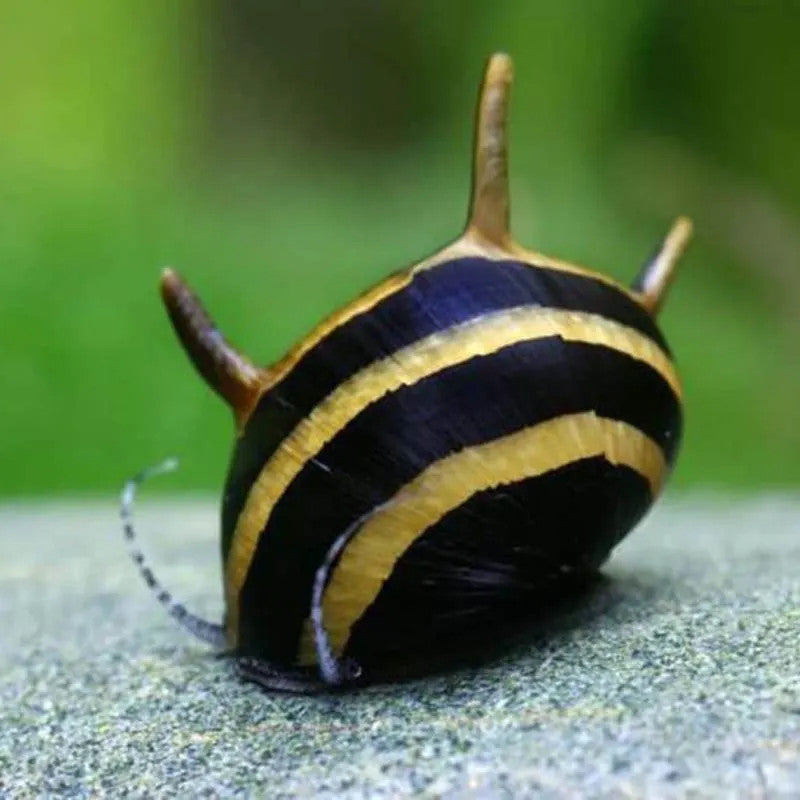DANBURY AQUARIUM
SPIRAL HORN
SPIRAL HORN
Couldn't load pickup availability
Delivered within 1-2 Weeks
Species: Spiral Horn Nerite Snail • Common Names: Spiral Horn Snail, Horned Nerite Snail • Natural Habitat: Found in freshwater and brackish waters of rivers and estuaries in regions like Southeast Asia and Africa, where they inhabit areas with rocky substrates. Physical Characteristics: • Appearance: Features a distinctive spiral-shaped shell with prominent horns or ridges, often exhibiting various color patterns, including stripes and mottled hues. The shell’s texture is robust and glossy. • Size: Typically grows up to 1-2 inches (2.5-5 cm) in diameter. • Lifespan: Can live for several years, usually around 3 to 5 years with appropriate care. Habitat Requirements: • Tank Size: A minimum of 10 gallons is suitable for a small group, providing enough space for movement and foraging. • Water Conditions: o Temperature: Prefers temperatures between 70-80°F (21-27°C). o pH: Thrives in a pH range of 7.0-8.5, tolerating brackish conditions. • Aquascaping: Requires a well-structured environment with rocky areas, driftwood, and plants to provide hiding spots and grazing surfaces. Diet: • Primary Diet: Herbivorous; primarily feeds on algae, biofilm, and detritus in their natural habitat. • Supplemental Feeding: Offer algae wafers, blanched vegetables, and high-quality sinking pellets designed for herbivorous snails. • Feeding Frequency: Feed small amounts once or twice daily to ensure proper nutrition without overfeeding. Compatibility: • Temperament: Generally peaceful and non-aggressive, making them suitable for community tanks. • Suitable Tank Mates: Compatible with a variety of peaceful fish and invertebrates, as well as live plants. • Incompatibilities: Avoid aggressive species that may harass or predate upon the snails. Care Level: • Difficulty: Considered easy to care for; they adapt well to a variety of water conditions. • Health Monitoring: Regularly check for signs of stress or shell damage, which can indicate poor water quality or nutritional deficiencies. Breeding: • Breeding in Captivity: Breeding in aquariums is challenging; they require specific conditions and tend to lay eggs that hatch in brackish water. • Spawning: Careful monitoring and optimal conditions are necessary to support any potential reproduction. Economic Considerations: • Market Demand: Increasingly popular among aquarists for their unique appearance and algae-eating capabilities. • Wholesale/Retail Pricing: Typically available at moderate prices, influenced by their unique traits and availability. Sustainability and Conservation: • Wild Population: Generally stable, but habitat degradation poses risks to their populations. • Aquaculture Efforts: Some success in captive breeding helps reduce reliance on wild populations. • Regulations: Adherence to local and international regulations ensures sustainable practices in their trade. Conclusion: The Spiral Horn Nerite Snail is an intriguing addition to freshwater and brackish aquariums, valued for its striking shell and beneficial algae-grazing behavior. With proper care and suitable tank conditions, these snails thrive, enriching the aquarium environment while providing enjoyment to aquarists of all levels.


